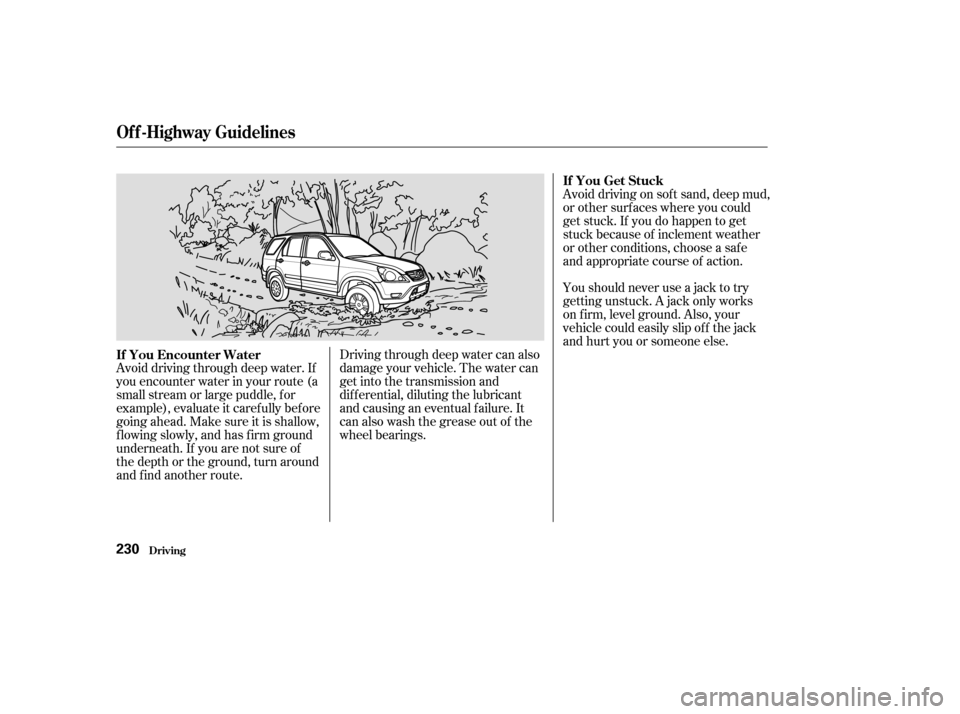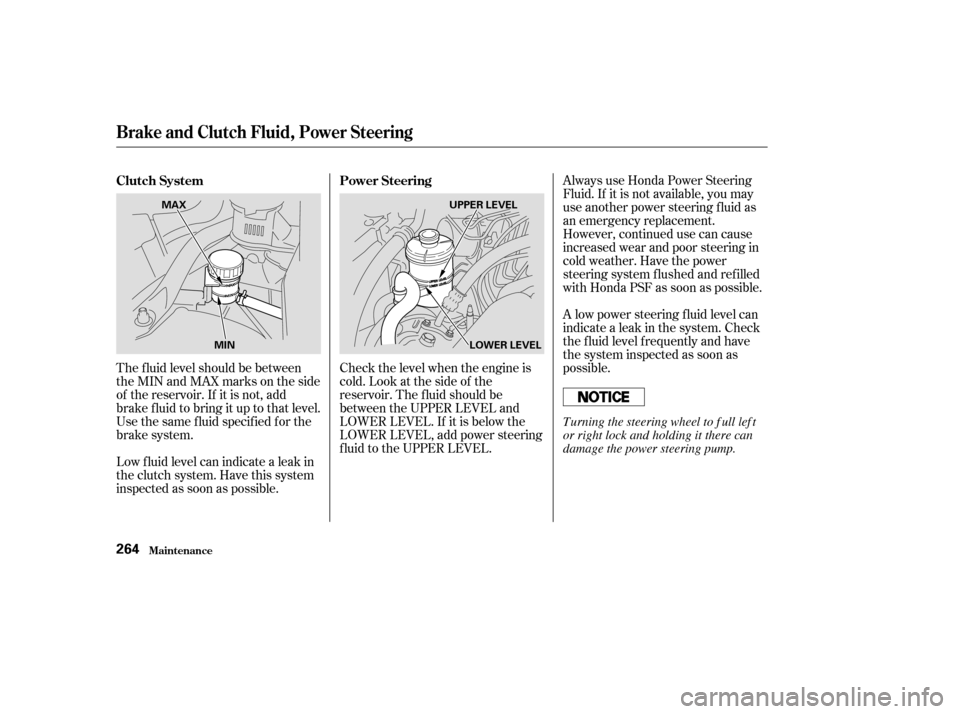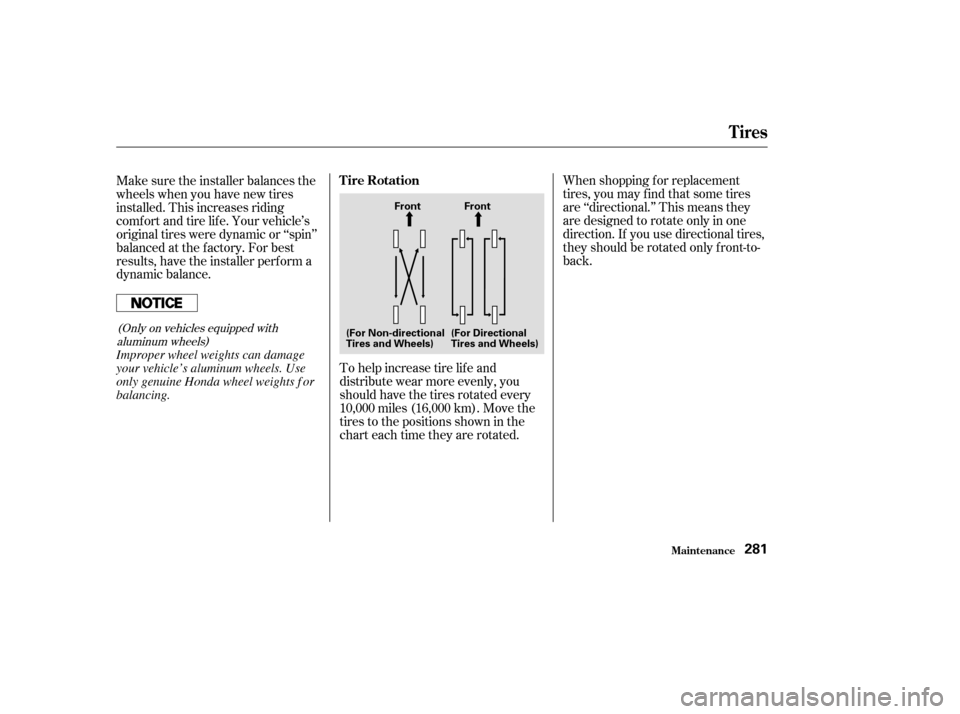2003 HONDA CR-V wheel
[x] Cancel search: wheelPage 233 of 374

Bumps, holes, rocks, and other
obstacles can be hazardous. Debris
in the road can damage your
suspension or other components.
Even small rocks can cut your tires.
More important, because your
vehicle has a high center of gravity,
driving over a large obstacle, or
allowing a wheel to drop into a deep
hole, can cause your vehicle to tip or
roll over.
Drive slow enough to observe
obstacles ahead and maneuver
around them. If you can’t avoid a
serious obstacle, turn around and
look f or a better route.
Bef ore driving up or down a hill, stop
and assess the situation. If you can’t
clearly see all road conditions (good
traction, no bumps, holes or other
obstacles, a safe way out, etc.) walk
the slope bef ore you drive on it. If
you have any doubt about whether
you can saf ely drive on the slope,
. Find another route.
If you are driving up a hill and f ind
that you cannot continue (because of
the steepness, a large obstacle, etc.), . Your vehicle
could roll over. Slowly back down the
hill, f ollowing the same route you
took up the hill.
You should have no problem making
sharp turns at low speed on level
ground. But never make an abrupt
turn at higher speeds, on or of f
pavement. With a higher center of
gravity, your vehicle can more easily
tip or roll over. Off-highway, the basic turning
technique is to drive at low speed
and gradually adjust the amount of
steering to suit the surf ace. Test your brakes from time to time
to make sure they are operating
properly. This will also give you a
f eel f or how much traction you have
on a given surf ace.
don’t do it
do not try to turn around
Avoiding Obstacles
Driving on Slopes
Off-Highway Guidelines
Driving
T urning
229
Page 234 of 374

Avoid driving through deep water. If
you encounter water in your route (a
small stream or large puddle, f or
example), evaluate it carefully before
going ahead. Make sure it is shallow,
f lowing slowly, and has f irm ground
underneath. If you are not sure of
the depth or the ground, turn around
andfindanotherroute.Driving through deep water can also
damage your vehicle. The water can
get into the transmission and
dif f erential, diluting the lubricant
and causing an eventual failure. It
can also wash the grease out of the
wheel bearings.You should never use a jack to try
getting unstuck. A jack only works
on f irm, level ground. Also, your
vehicle could easily slip of f the jack
and hurt you or someone else. Avoid driving on sof t sand, deep mud,
or other surf aces where you could
get stuck. If you do happen to get
stuck because of inclement weather
or other conditions, choose a saf e
and appropriate course of action.
If You Encounter Water If You Get Stuck
Off-Highway Guidelines
Driving230
Page 235 of 374

If you spin the wheels excessively
trying to get unstuck, you may
overheat the components of the
4-wheel drive system. If this happens,
the 4-wheel drive system shuts off
and only the f ront wheels receive
power. If this happens, stop and
allow everything to cool down. The
4-wheel drive system will work again
after its temperature drops.
If you slip the clutch f or a long time
while trying to get unstuck, you may
overheat and damage it.
Off-Highway Guidelines
Driving
4-Wheel Drive Vehicles
231
Page 237 of 374

This section explains why it is
important to keep your vehicle well
maintained and to f ollow basic
maintenance saf ety precautions.
This section also includes
Maintenance Schedules f or normal
driving and severe driving conditions,
a Maintenance Record, and instruc-
tions f or simple maintenance tasks
you may want to take care of
yourself .
If you have the skills and tools to per-
f orm more complex maintenance
tasks on your Honda, you may want
to purchase the Service Manual. See
page f or inf ormation on how to
obtain a copy, or see your Honda
dealer.......................
Maintenance Saf ety .234
.
Important Safety Precautions . 235
.................
Maintenance Schedule . 236 ...
Required Maintenance Record . 243
.......
Owner Maintenance Checks . 245
..............................
Fluid Locations .246
......................................
Engine Oil .247
..................................
Adding Oil .247
....................
Recommended Oil .247
..............................
Synthetic Oil .248
....................................
Additives .248
.....
Changing the Oil and Filter . 249
.............................
Cooling System .251
............
Adding Engine Coolant . 251
.......
Replacing Engine Coolant . 253
....................
Windshield Washers .258
.......................
Transmission Fluid .260
..........
Automatic Transmission . 260
5-speed Manual .........................
Transmission .261
.................
Rear Dif f erential Fluid . 262
................
Brake and Clutch Fluid . 263
............................
Brake System .263
...........................
Clutch System .264
..............................
Power Steering .264
.....................
Air Cleaner Element .265
....................................
Hood Latch .266
....................................
Spark Plugs .267
..............................
Replacement .267 ............................
Specif ications .268
...........................................
Battery .269
.................................
Wiper Blades .271
..............
Air Conditioning System . 274
..................
Dust and Pollen Filter . 275
.......................................
Drive Belt .277
...............................................
Tires .278
......................................
Inf lation .278
Recommended Tire Pressures f or Normal ...........................
Driving .279
Tire Pressure Adjustment f or ..........
High Speed Driving . 279
..................................
Inspection .280
..............................
Maintenance .280
.............................
Tire Rotation .281
...
Replacing Tires and Wheels . 282
......................
Wheels and Tires .283
..........................
Winter Driving .283
.............................
Snow Tires .283
............................
Tire Chains .284
.............................................
Lights .285
.....................
Headlight Aiming .287
........................
Replacing Bulbs .287
....................
Storing Your Vehicle .295
357
Maintenance
Maint enance233
Page 268 of 374

Always use Honda Power Steering
Fluid. If it is not available, you may
use another power steering f luid as
an emergency replacement.
However, continued use can cause
increased wear and poor steering in
cold weather. Have the power
steering system f lushed and ref illed
with Honda PSF as soon as possible.
A low power steering f luid level can
indicate a leak in the system. Check
the f luid level f requently and have
the system inspected as soon as
possible.
Check the level when the engine is
cold. Look at the side of the
reservoir. The f luid should be
between the UPPER LEVEL and
LOWER LEVEL. If it is below the
LOWER LEVEL, add power steering
f luid to the UPPER LEVEL.
The f luid level should be between
theMINandMAXmarksontheside
of the reservoir. If it is not, add
brake f luid to bring it up to that level.
Use the same fluid specified for the
brake system.
Low f luid level can indicate a leak in
the clutch system. Have this system
inspected as soon as possible. Power Steering
Clutch System
Maint enance
Brake and Clutch Fluid, Power Steering
264
MAX
MIN UPPER LEVEL
LOWER LEVEL
T urning the steering wheel to f ull lef t
or right lock and holding it there can
damage the power steering pump.
Page 284 of 374

Every time you check inf lation, you
should also examine the tires f or
damage, f oreign objects, and wear.
Youshouldlookfor:Bumps or bulges in the tread or
side of the tire. Replace the tire if
youfindeitherof theseconditions.
Excessive tread wear. In addition to proper inf lation,
correct wheel alignment helps to
decrease tire wear. If you f ind a tire
is worn unevenly, have your dealer
check the wheel alignment.
Cuts, splits, or cracks in the side
of the tire. Replace the tire if you
can see f abric or cord. Your vehicle’s tires have wear indica-
tors molded into the tread. When the
tread wears down to that point, you
will see a 1/2 inch (12.7 mm) wide
band running across the tread. This
shows there is less than 1/16 inch
(1.6 mm) of tread lef t on the tire. A
tire that is this worn gives very little
traction on wet roads. You should
replace the tire if you can see the
tread wear indicator in three or more
places around the tire. The tires were properly balanced by
the factory. They may need to be
rebalanced at some time bef ore they
are worn out. Have your dealer
check the tires if you f eel a consis-
tent vibration while driving. A tire
should always be rebalanced if it is
removed f rom the wheel f or repair.
Inspection
Maintenance
Tires
Maint enance280
INDICATOR LOCATION MARKS
TREAD WEAR INDICATORS
Page 285 of 374

When shopping f or replacement
tires, you may find that some tires
are ‘‘directional.’’ This means they
are designed to rotate only in one
direction. If you use directional tires,
they should be rotated only front-to-
back.
Make sure the installer balances the
wheels when you have new tires
installed. This increases riding
comf ort and tire lif e. Your vehicle’s
original tires were dynamic or ‘‘spin’’
balanced at the f actory. For best
results, have the installer perf orm a
dynamic balance.
To help increase tire lif e and
distribute wear more evenly, you
should have the tires rotated every
10,000 miles (16,000 km). Move the
tires to the positions shown in the
chart each time they are rotated.
(Only on vehicles equipped withaluminum wheels)
Tire Rotation
Tires
Maint enance281
Front Front
(For Non-directional
Tires and Wheels) (For Directional
Tires and Wheels)
Improper wheel weights can damage
your vehicle’s aluminum wheels. Use
only genuine Honda wheel weights f or
balancing.
Page 286 of 374

It is best to replace all f our tires at
thesametime.If thatisnotpossible
or necessary, then replace the two
f ront tires or the two rear tires as a
pair. Replacing just one tire can
seriously af f ect your vehicle’s han-
dling.
The tires that came with your
vehicle were selected to match the
perf ormance capabilities of the
vehicle while providing the best
combination of handling, ride
comfort,andlonglife.Youshould
replace them with radial tires of the
same size, load range, speed rating,
and maximum cold tire pressure
rating (as shown on the tire’s
sidewall). Mixing radial and bias-ply
tires on your vehicle can reduce its
braking ability, traction, and steering
accuracy.
TheABSworksbycomparingthe
speed of the wheels. When replacing
tires, use the same size originally
supplied with the vehicle. Tire size
and construction can affect wheel
speed and may cause the system to
work inconsistently.
If you ever need to replace a wheel,
make sure the wheel’s specif ications
match those of the original wheel
that came on your vehicle. Re-
placement wheels are available at
your Honda dealer.
Replacing T ires and Wheels
Tires
Maint enance282
Installing improper tires on your
vehicle can affect handling and
stability. This can cause a crash
in which you can be seriously
hurt or killed.
Always use the size and type of
tires recommended in this
owner’s manual.